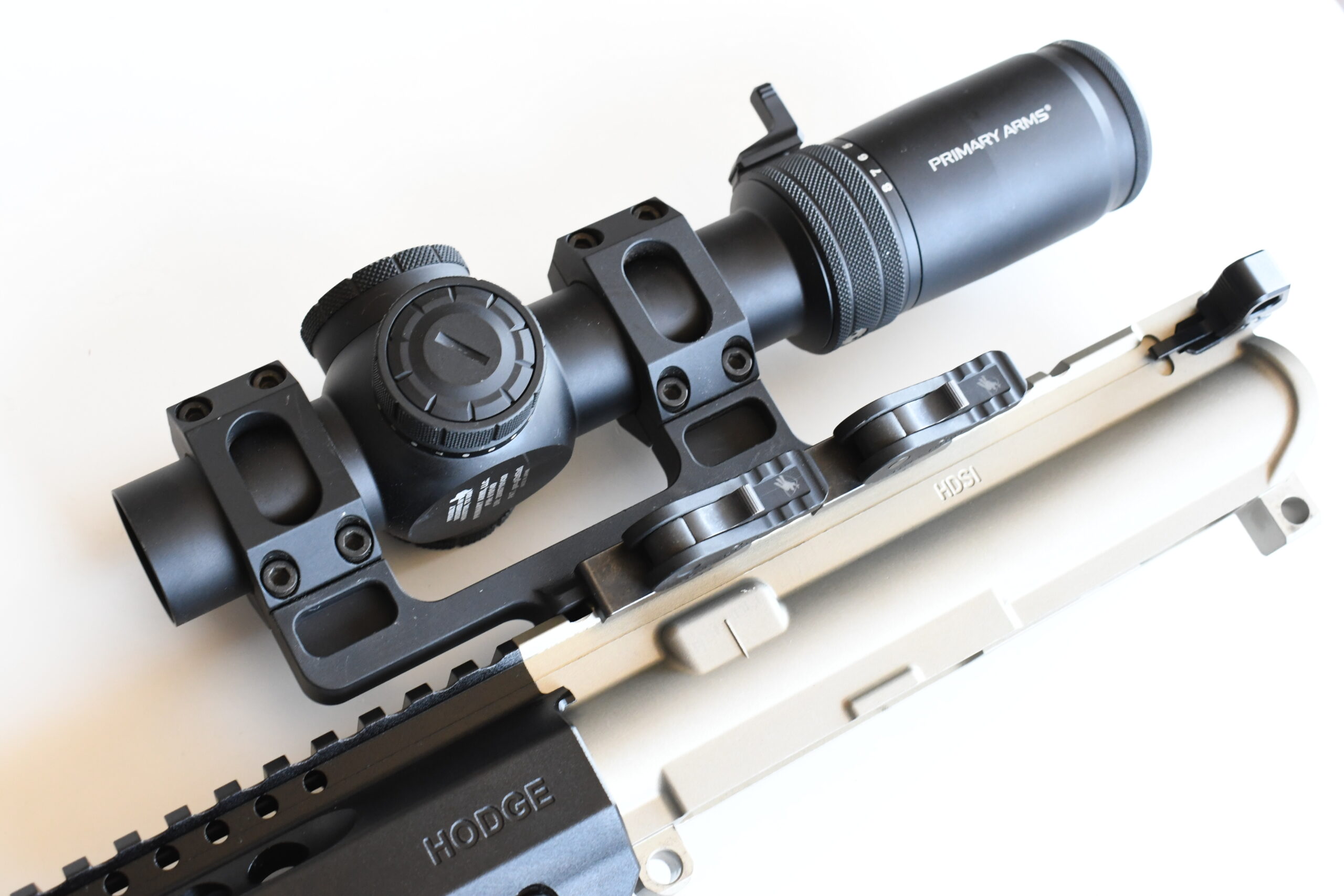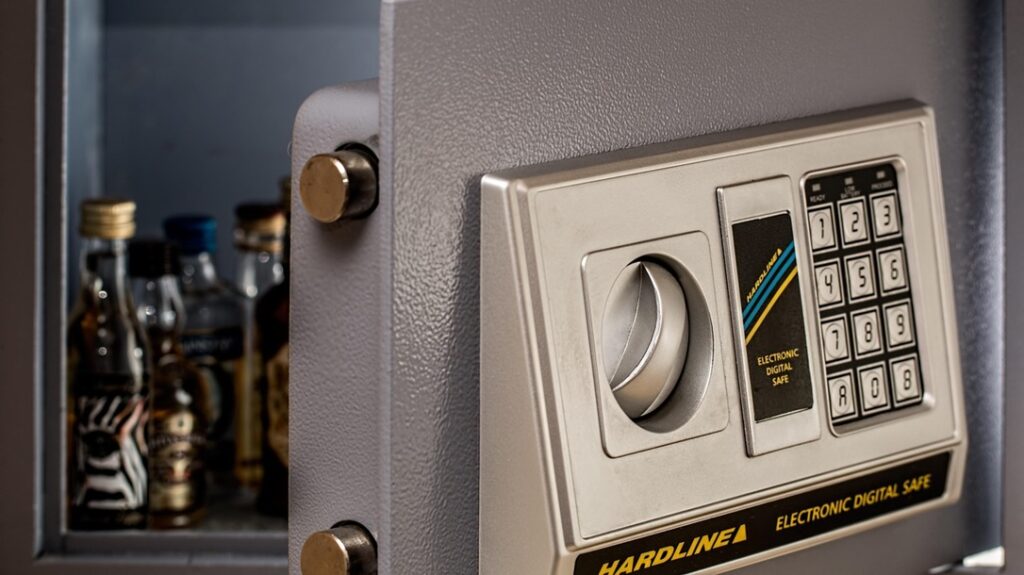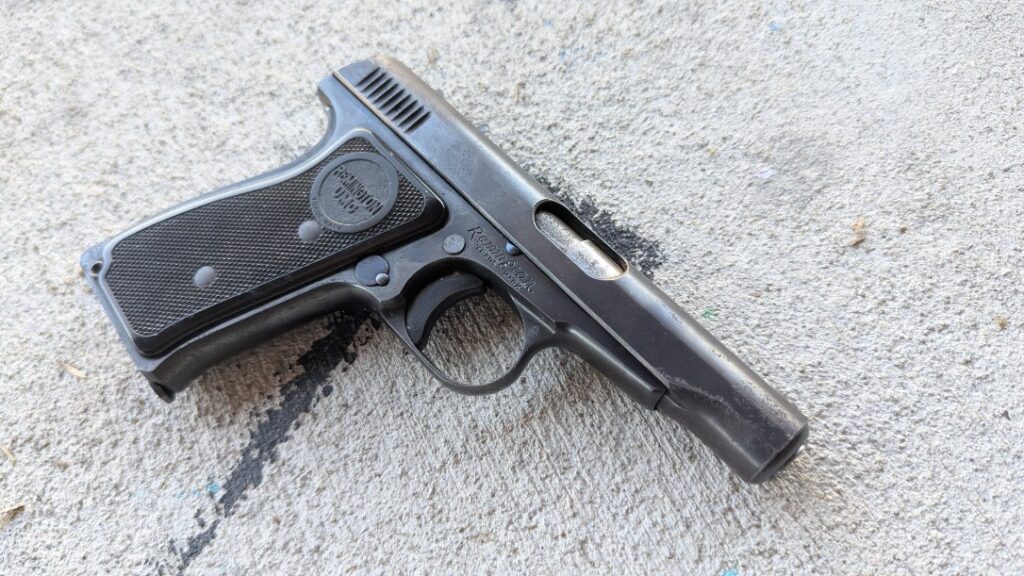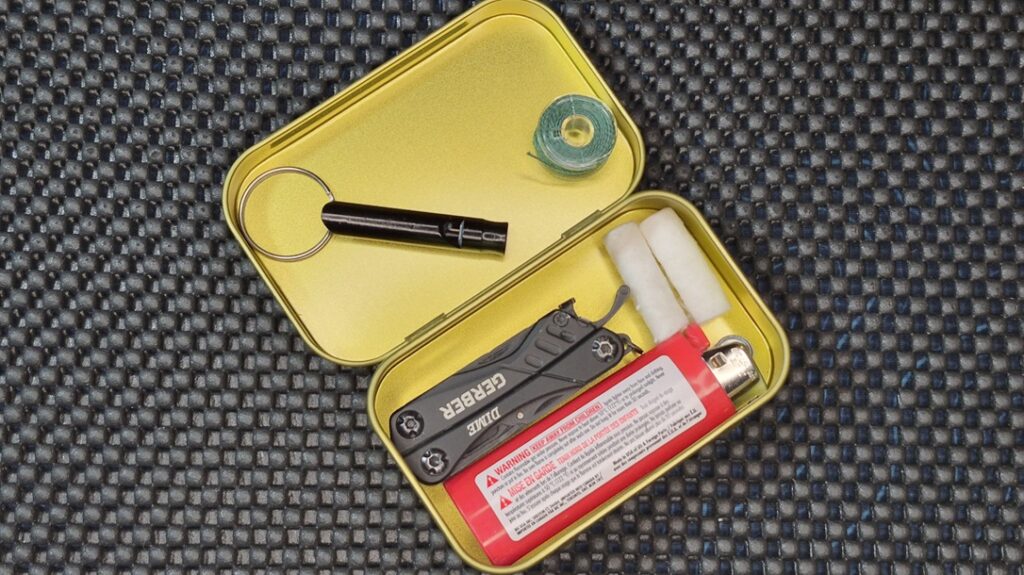Continued from Part 1
ACSS Griffin Mil M8 Reticle
At 1x Zoom

The Primary Arms Optics ACSS Griffin Mil reticle is probably best described as a jack-of-all-trades multi-purpose reticle. And Because the PLxC is a first focal plane scope, the reticle will shrink or grow depending on the level of zoom adjustment. This means that shooters will naturally perceive and see the reticle differently at 1x magnification than they would at the full 8x magnification.
Advertisement — Continue Reading Below
On its lowest setting, the ACSS Griffin reticle looks nearly like a traditional duplex crosshair, with very thick outer stadia lines that taper and then disappear leaving only a floating horseshoe-ring with a centrally placed aiming chevron.
At 8x Zoom
On the flip side, when adjusted to higher levels of magnification, the thick duplex crosshair lines disappear, and both the horseshoe ring and aiming chevron are greatly expanded. In fact, this chevron is the nucleus of the ACSS Griffin reticle. It measures 2-mils wide and floats over a milliradian-based grid while being enveloped by that outer “CQB” horseshoe ring.

Advertisement — Continue Reading Below
At 1-mil beneath the aiming tip of the chevron, the ACSS Griffin has a vertical stadia line that bisects a grid of points spaced out 1-mil apart. This vertical stadia line itself has its own markings spaced at ½ mil and 1-mil intervals that extend all the way down to 15 mils.
Distance Ranging with the ACSS Griffin Reticle
The ACSS Griffin reticle features some quick-and-dirty distance-ranging tricks. For example, at 300 meters, the 19-inch width of an IPSC/USPSA paper target will fit flush with the central aiming chevron. At 400 meters, the same common 19-inch wide target fits flush against the slightly wider horizontal line found 2 mils below, on the vertical stadia line.
Furthermore, the design team at Primary Arms Optics also incorporated a pair of symmetrical “ranging wings” to the left or right of the principal horseshoe. These lines are also vertical and can be used to range 170 cm tall targets from 300 to 600 meters. In essence, with its thick horseshoe ring, a regulated central vertical stadia line, the grid of 1×1-mil spaced dots, and these “ranging wings,” it’s evident that the ACSS Griffin Mil M8 reticle was created to fully take advantage of the versatility of a riflescope with this level of variable magnification.
Advertisement — Continue Reading Below
Primary Arms even ships a separate booklet focusing on only this reticle with useful information and excellent diagrams. I briefly touched on this in Part 1, but PA even ships an exposed elevation turret knob for those who would like to shoot and dial as if they were using a traditional riflescope. I don’t think it’s necessary on any LPVO but I appreciate the thought and detail once again.
Shooting Experiences With the Primary Arms PLxC 1-8 LPVO
At the time of this writing, I’ve fired a few hundred rounds of 5.56 NATO ammunition along with scores of .22 LR cartridges with the aid of this LPVO. I can’t comment on what it’s like to jump out of a helicopter with the PLxC mounted on a SOPMOD Block II carbine, but its quality construction suggests that it would hold up just fine….with “regular-guy” use at the range, classes or matches anyway. This is all I can personally speak for anyway.
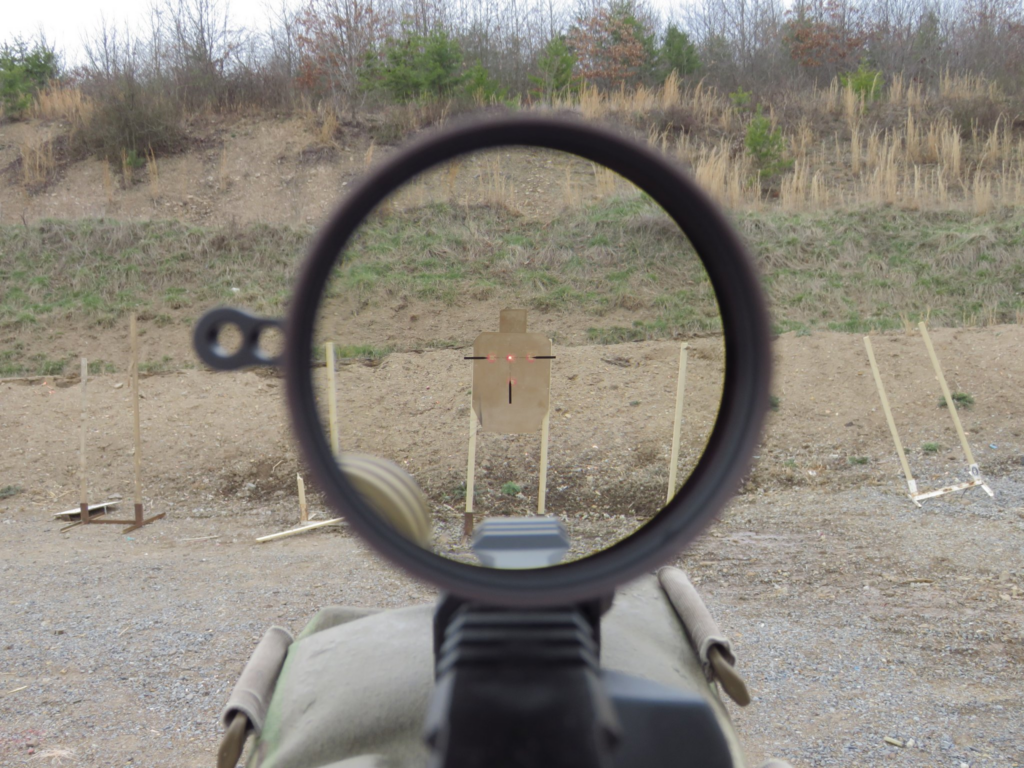
Advertisement — Continue Reading Below
At 1x Zoom
The product page on the Primary Arms website for the PLxC mentions the scope’s generous field of view when cranked down to 1x. I think it checks out. With an eye box that measures approximately 3.5 inches, looking through the PLxC at its lowest magnification setting feels similar to looking through the Vortex Razor LPVO series. At this magnification, one perceives the edge of the scope to be extremely thin and the eye mostly sees a generous field of view. I included a picture of the Vortex on the right to show what I’m talking about.
I’ve noticed that regardless of scope mount height, when using both eyes open, the shooter’s eyes have to sit squarely with the PLxC’s eyebox for a crisp and clear picture. Otherwise, one might find some slight scope shadow. I’ve found that the best way to prevent this is by staying focused on the target and simply bringing up the carbine to one’s face.
Running the Primary Arms PLxC
In addition to dry-fire around the house or the backyard, I’ve been taking this LPVO mounted to a Smith & Wesson M&P 15-22 (pictured in Part 1) to a Steel Challenge match and participated with it under the “rimfire rifle open” division.
Advertisement — Continue Reading Below
Steel Challenge is all about shooting bigger, close-distance targets as quickly as possible. It was a good exercise to put this optic through. These are summer matches held in the evening, with the sun shifting over the horizon at twilight. With the uneven lighting I find that “duplex-esque” outer stadia lines do help to ensure that my reticle is properly aligned with the steel plates from the match.
In bright daylight, the ACSS Griffin’s horseshoe abets the shooter by granting them a good-sized “quick” targeting ring. This is why many shooters opt for these—especially on low-zoom magnified optics like LPVOs or prismatic sights—when shooting targets like IPSC/USPSA paper targets or A/C-zone steel plates.
I can definitely understand why the appeal is there, and in the case of Steel Challenge—well, a red dot is always going to be faster. However, I was able to hold my own using this LPVO, too.
Advertisement — Continue Reading Below
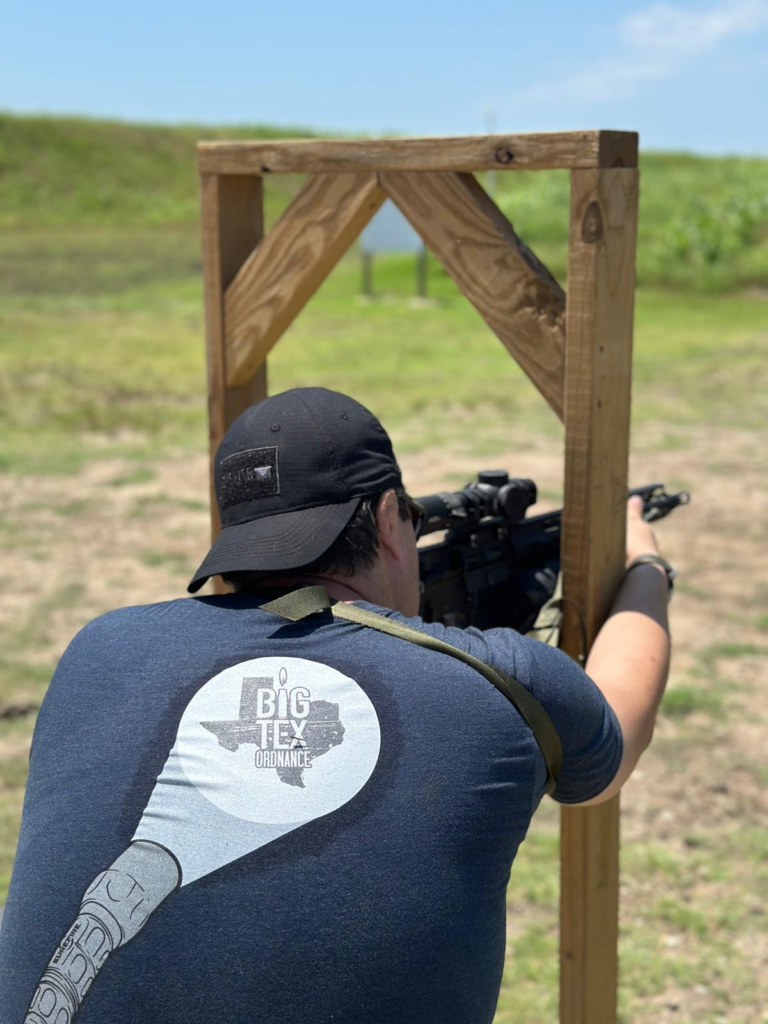
Zoomed In At 8x
In the world of shooting, everything is about trade-offs and compromises, and shooting LPVOs adjusted to their higher magnifications is no exception. In short, LPVOs don’t mirror the exact functionality that standard riflescopes have. Instead, LPVOs are stuck with fixed parallax settings and tighter-than-normal eyeboxes at full magnification, among other things.
LPVOs aren’t precision riflescopes, but they certainly work better than red dots and magnifiers, especially on general-purpose carbines. This is why many others, including myself, consider LPVOs worth the hassle.
Advertisement — Continue Reading Below
Proving Grounds
I’m extremely glad that in the previously mentioned Cornerstone Performance LPVO course, we students had ample chances to shoot at different size targets from barricades at distances of 275 yards plus. These are very healthy distances for general-purpose 5.56mm carbines shooting A/C-zone-sized targets. This afforded me the opportunity to spend some time shooting with the PLxC’s reticle at full magnification, mostly off bag and barricade.
One of the first things I had to do was readjust the diopter’s prescription and twist the focus ring to a different setting than how I had adjusted it for the best 1x view. While I haven’t reviewed every currently available LPVO ever made, this is the first scope that I’ve used extensively that needed its focus ring set differently at low and high magnifications for the clearest picture.
My educated guess is that it may have something to do with the manner in which the lenses are stacked inside the optic with respect to both the size and length of the optic. After adjusting the focus ring for the right prescription, I didn’t have too much trouble shooting at 8x magnification with a proper index off the carbine stock.
Advertisement — Continue Reading Below
The Magpul STR (shown on the rifle below) is a heavy but comfortable stock. Its sloped surface allowed me to get comfortable while fully zoomed in. From a physical standpoint, I have no real complaints about this LPVO. However, I do have some critiques of the reticle, which I’ll cover in Part 3.

Review to be continued in Part 3…
